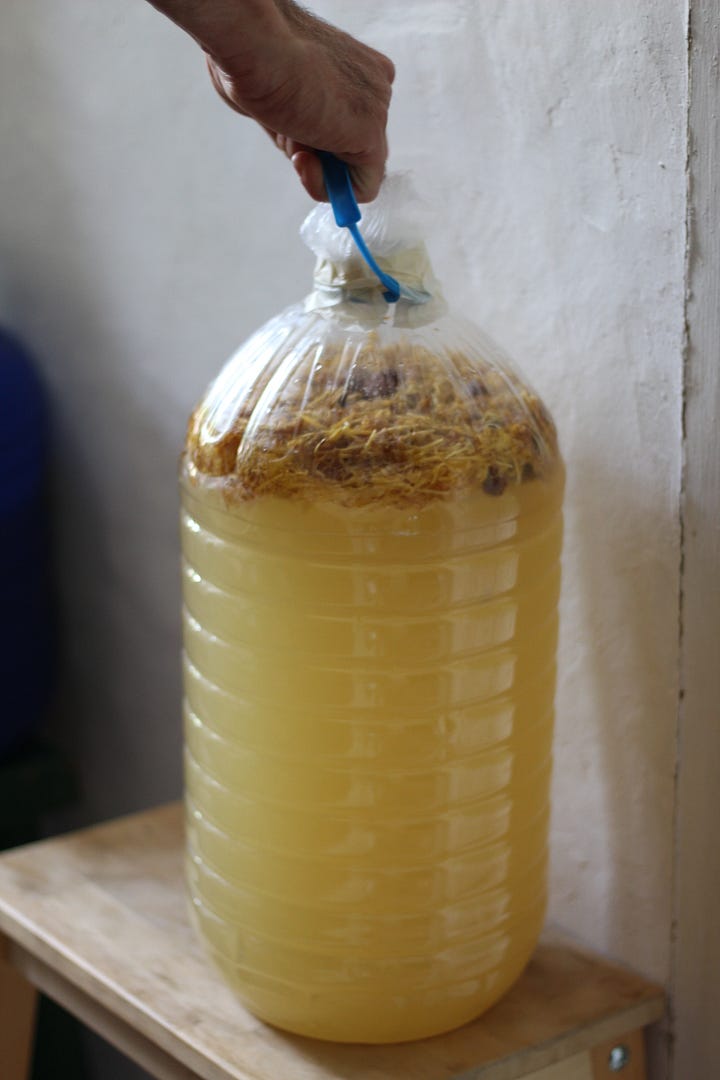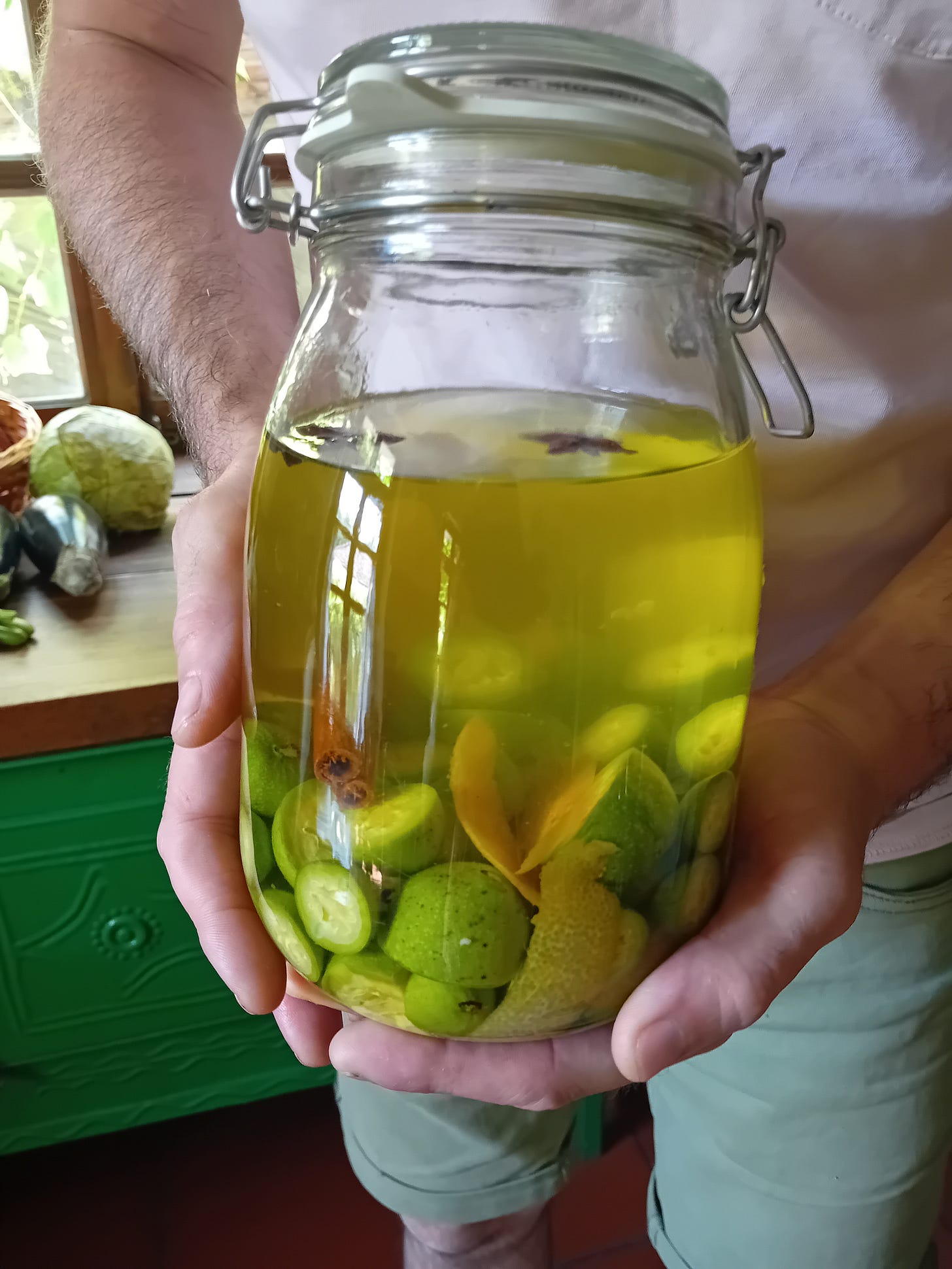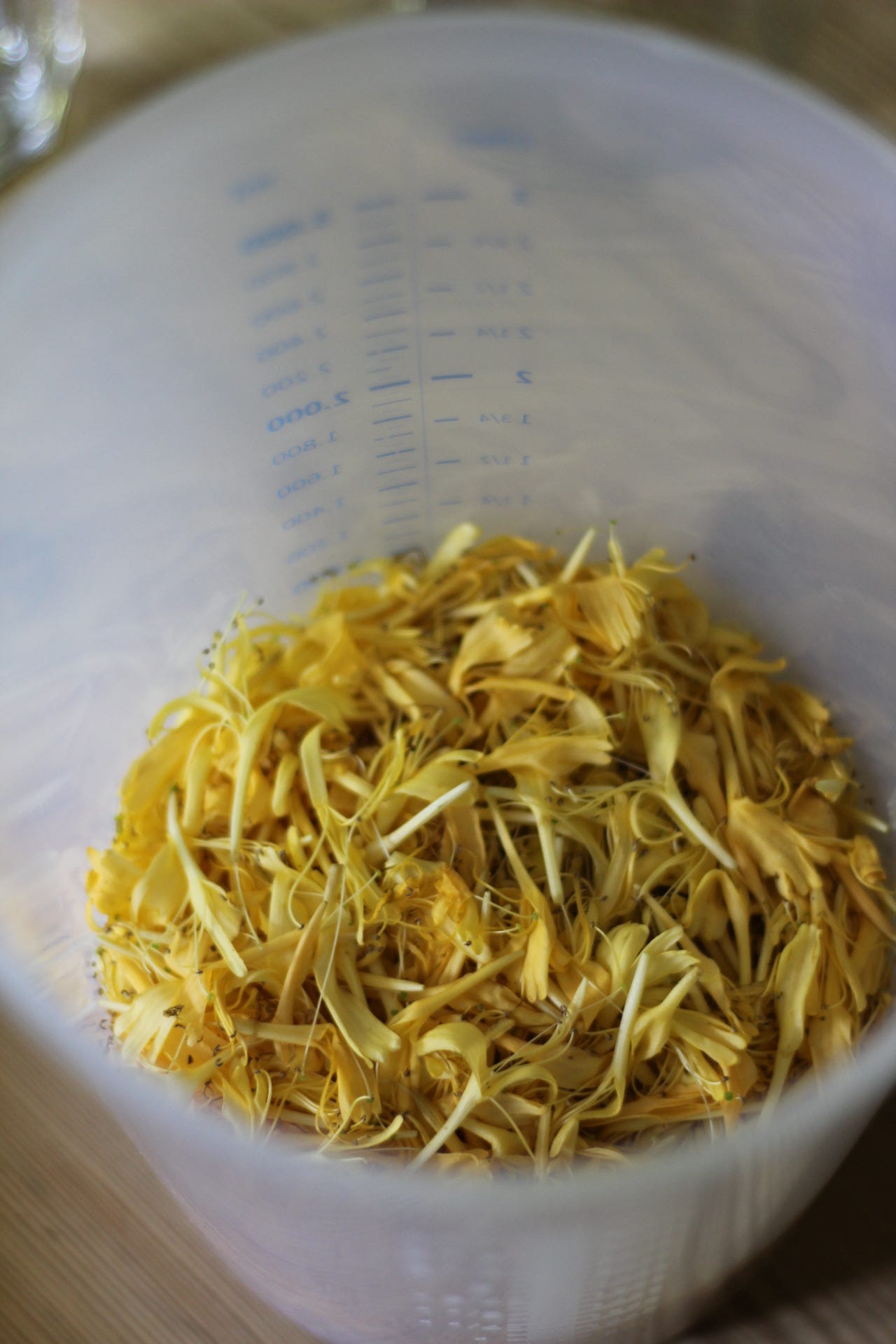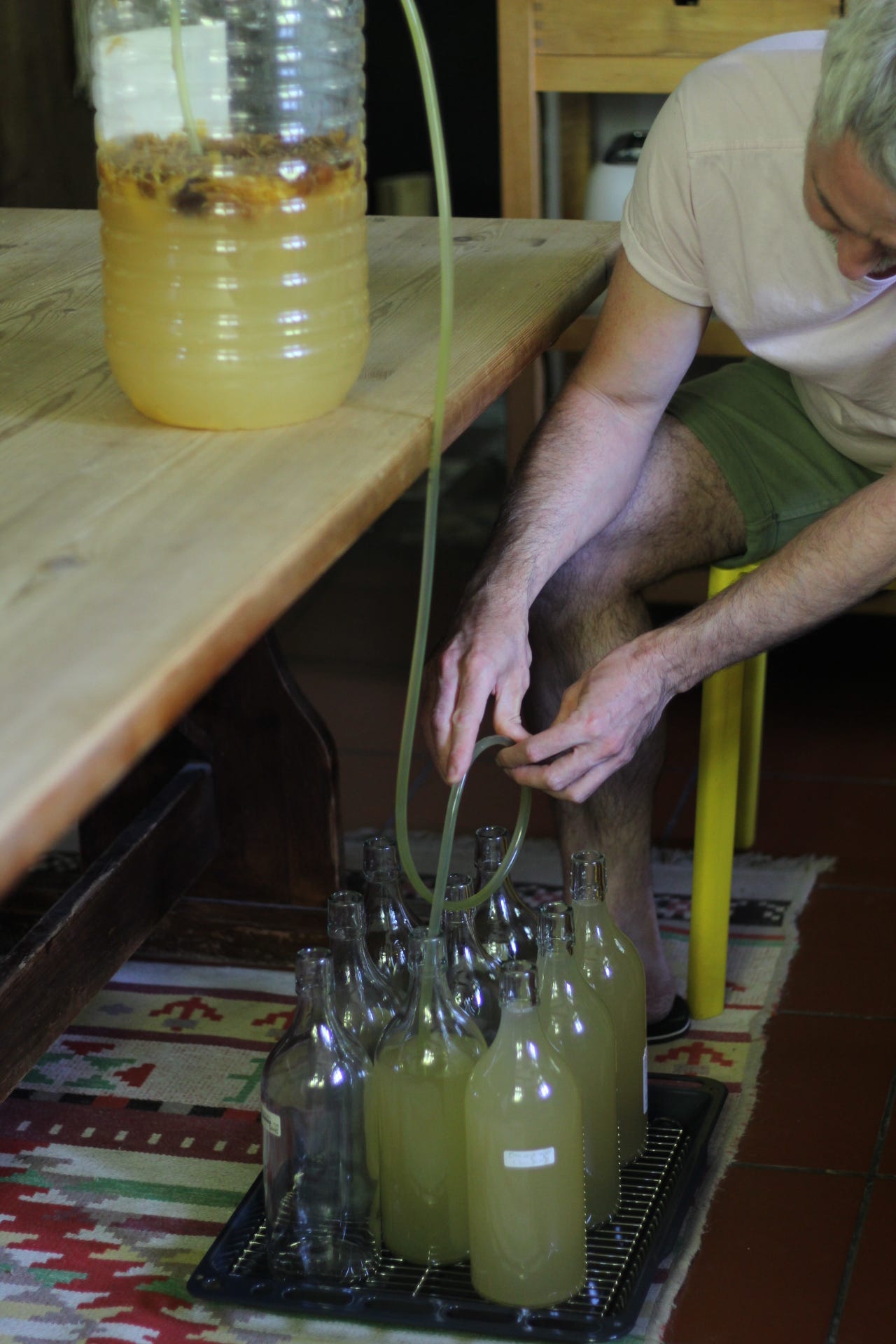Sparkling honeysuckle wine, daydream believing
How following my nose led to a new booze experiment.
Before we moved to Bulgaria, I indulged in constant, potent daydreams of life here. Physically, I’d be at my desk in Balham, but mentally I’d be sowing seeds or harvesting food from my imagined garden. I’d be on the commute back to Portsmouth, probably eating a bag of McCoys, but dreaming of baking bread in a country kitchen. I’d be in the queue in Co-op, imagining myself wafting around the garden in a floaty dress picking flowers. (My imagined self always wafted. In reality, I’m a stomper.)
These days we’d call it manifesting. But back in the late 2000s, unless you’d read The Secret, which I hadn’t, it was just daydreaming. And boy, did it keep me sane through the two years of saving and waiting and saving and waiting.
I can’t remember if homemade alcohol was part of the rotating daydream library.
We were always keen on the idea of making cider – at one point we even toyed with starting a microbrewery – so there was probably the occasional daydream of sitting on a pristine picnic blanket and popping open a bottle of something homemade. (Again, the reality is quite different: our homemade cider is hella explosive, so we have to open it over a 3-litre plastic catering jug, with a tea towel draped over the top. Distinctly less romantic.)
It's no surprise our homemade alcohol journey started with cider, and you can read about our cider-making process on my old Auntie Bulgaria blog. We were also lucky to inherit several grapevines in our garden, so Rob has made wine for most of the last 14 years, to varying degrees of success. (In a good year, we can have 20 or so litres of very drinkable homemade wine. In an alright year, we end up with 20 or so litres of homemade vinegar. In a bad year, we end up with a lot of mess, and nothing drinkable or useable. Winemaking is hard, yo.)
From there, we’ve expanded to several liqueurs and other boozy things.
We make nocino – the Italian liqueur made from unripe green walnuts – every summer, so it’s ready in time for Christmas. We often make our own Chambord. (I love a French martini at Christmas. I don’t care how 80s it is. If anything, it only makes me love it more.) And I’m still working my way through the crème de mure I made in a blackberry-stained frenzy years ago. (Why did I think I’d need three litres of the stuff? Answers on a postcard please.)
In a tragic oversight, we’d never made elderflower wine until last summer. Despite living about 30 metres from several elder trees. Now that’s rectified, elderflower wine has seamlessly become part of our boozemaking calendar. It’s a fairly full calendar these days, what with ginger wine in the winter, red and white wine in the autumn, cider in the autumn, and elderflower wine and nocino in the summer. It’s a tough life.
And this is what brings us to honeysuckle wine…
We had a carrier bag full of elderflower heads and were walking back through the gate, shoving aside the honeysuckle hedge thatch that grows along our front fence.
I paused to breathe in the honeysuckle scent and said, ‘That smells like something I want to drink.’
We looked at each other, simultaneous lightbulbs going off above our heads.
‘Is honeysuckle wine a thing?’ I asked.
Google told us it was. And, ever one to do what the internet tells me, I spent a very hot and sweaty hour plundering the front honeysuckle hedge thatch, teasing off the yellow flowers.
Recipe for sparkling honeysuckle wine
Okay, so we basically repeated our process for sparkling elderflower wine, but using honeysuckle flowers instead. For elderflower wine, we follow the recipe in the River Cottage Booze handbook by John Wright, which is a great book for would-be homebrewers. Also, the author once spent a drunken night in a phone box in Cosham, where I grew up. (Cosham, that is, not a phone box.) There’s no earthly reason for anyone to come to Cosham, so this baffles and amuses me in equal measure. I’m dying to know more…
Given that sparkling elderflower wine is famously explosive, he offers two methods: ‘quick and reckless’ and ‘tried and trusted’. We favour the quick and reckless route.
Makes around 10 litres (and is adapted from the River Cottage elderflower wine recipe)
Note: you want your honeysuckle flowers to be at the yellow (not white) stage, as this is when they have the most honeyed flavour. Make sure you remove any green stems and tips. Don’t scrimp on this. Only the flowers themselves are edible – the rest of the plant is toxic.
You will need:
1 litre or 6 cups honeysuckle flowers, at the yellow stage, green bits removed
8 litres filtered or bottled water
1.6 kilos sugar
Zest and juice of one lemon and one lime (or 2 lemons)
Handful of raisins (or ½ tsp yeast nutrient)
5g champagne yeast (I buy this on Amazon, don’t hate me)
Start by sterilising your fermenting vessel. We used an empty 11-litre mineral water bottle because we are glamorous. In Bulgaria, folks commonly use big plastic screw-top tubs for homebrewing. Or you could use a proper demijohn if you have one big enough. You can find various ways to sterilise your vessel online, but we follow the method using chlorine-based bleach (also in the River Cottage book).
Pick over the honeysuckle flowers, just to make sure you’ve removed any green bits.
In a large pan, warm 4 litres of the water and dissolve the sugar in it. Then top up with the remaining 4 litres of water.
Add the sugar water to your sterilised fermenting vessel, along with the flowers and all of the remaining ingredients. Stir to combine.
Attach an airlock, if you have one for your demijohn, or you can simply secure a food bag over the top (some people use a balloon). This seals the vessel while still letting the gasses escape.


Leave to ferment for 7 or 8 days. In theory you should stir it every day but Rob just gave the bottle a quick daily swill. Mmm, quick daily swill.
Now it’s time to bottle the wine, which means – yippee – more sterilising. (Homebrewing is 90% sterilising stuff.) The easiest way to transfer the wine into bottles without having to strain out the flowers is just to use a plastic tube and syphon the liquid out. Sterilise the tube by boiling it in water for a few minutes. To sterilise the bottles, treat them like jam jars – so wash in hot soapy water, then put them in a low oven (say, 120°C) for 15–20 minutes. Meanwhile, sterilise the lids separately by boiling them for a few minutes. We always use bottles with flip-top stopper lids.
Syphon the liquid from the fermenting vessel into the sterilised bottles and seal tightly. (You can then compost the flowers.) Store the bottles in a cool room for around a week – this is the second fermentation, where carbonation builds up.
After a week, burp the bottles to release the buildup of gasses. This can be a bit messy if your wine is already lively, so you might want to stand the bottles in a washing up bowl to catch any liquid that bubbles over.
Leave for another week, then it’s ready to drink. You can leave it longer – we’ll be saving plenty for my birthday in August – but you might have to continue burping the bottles every week or two to release the gasses.
Be sure to store the wine in a cool place, away from sunlight, and not in front of any hot pipes hidden behind the wall (speaking from past experience, after a cider explosion). If you’re worried the wine is too lively and in danger of exploding,* transfer it to the fridge.
*We really rate the IKEA glass bottles with flip-top lids. They’re sturdy and the only time we’ve ever had one explode is when we accidentally stored some cider in front of a hot water pipe. Otherwise, they’ve not let us down, even when following the ‘quick and reckless’ elderflower wine recipe. That said, you are making this at your own risk. I’m not liable for any exploding bottles. Or hangovers.
The result?
We sampled some of the honeysuckle wine just before bottling and it tastes … of honey. Like a meady sort of wine. Delicious.
So now I’m dreaming of a summer filled with lazy hammock afternoons, sipping on homemade honeysuckle (and elderflower) wine. Here’s to daydreaming. Anyone who thinks daydreaming is a waste of time can eat my dungarees.
What to eat this week: who the hell knows
Just after we bottled the honeysuckle wine, I flew to the UK for a visit. So, to be honest, for the past week I’ve mostly been eating vegan chocolate and hazelnut spread straight from the jar. It’s been too hot to cook. Even though it’s nowhere near as hot as Bulgaria, the heat in the UK just hits different. It’s a whole other kind of sweaty.
When I can be bothered to eat ‘proper’ food, I’ve been enjoying smoked tofu sandwiches – which are much better than they sound. Thick wholemeal bread. Coconut yoghurt slathered on one slice of bread, red pepper hummus on the other. Loads of black pepper on both. Thinly shaved smoked tofu, and some sliced tomatoes. Honestly very good. My new favourite sandwich, and 100% better than literally the only vegan sandwich option available in the UK (falafel wrap. I like a falafel wrap as much as the next vegan but, come on, give us something else for a change).
I also saw this very enticing sweet and spiced seeded salad dressing on
and it’s exactly the sort of dressing I like. Miso. Loads of seeds. Generous amount of maple syrup. Love how she says it ‘pokes its nose into every nook’. Yes, please.Next time, I’ll be back in Bulgaria, where we’ll be harvesting lots from the garden. See you then, daydreamers.
Thank you for being here. Please hit the like button if you enjoyed this piece, as it really helps others find it.









Hi Claire - Nice piece. I , for one, prefer food writing that features a healthy dose of the terms "toxic" and "explosions". See if you can perhaps work "botulism" in too! Also very much enjoyed the multimedia event that was the Gardening Bore Tour. Hope you and Poor Rob are well!
Loved this piece. More flowery booze - yes please! I don't have a honeysuckle but will go out looking for one. Otherwise might try the same thing with lime flowers which I think are about to appear...